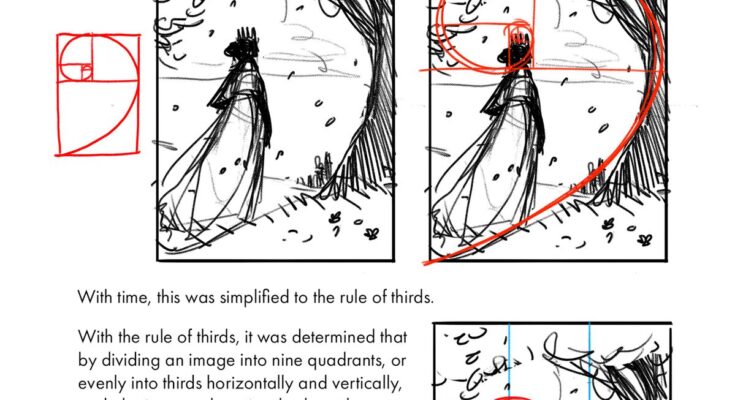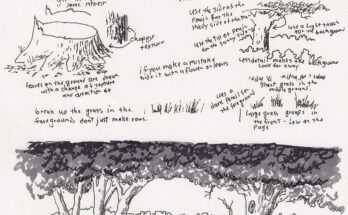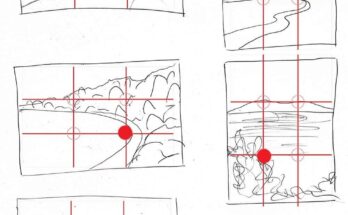Mastering Classical Composition: Harnessing the Golden Ratio and Rule of Thirds for Dynamic Artworks Inspired by Nature and Mathematics

In the timeless pursuit of creating balanced, harmonious, and visually compelling artworks, classical composition techniques rooted in mathematics and natural patterns offer artists an invaluable framework. This in-depth tutorial is inspired by a hand-drawn instructional reference page on “Classical Composition,” which explores the Golden Ratio—also known as the Divine Proportion or Phi (approximately 1:1.618)—and its simplification into the Rule of Thirds. The image features explanatory text linking the Golden Ratio to the Fibonacci Sequence found in nature (e.g., nautilus shells), alongside pencil sketches of ethereal female figures in forested landscapes, overlaid with red spirals, grids, and circles to demonstrate application. These illustrations show a progression from abstract mathematical concepts to practical scene setups, emphasizing how dividing an image into proportional segments guides the placement of focal points for maximum impact. The reference simplifies complex ideas, noting “WOOF, math. For an artist’s purposes, it looks like a nautilus shell,” and transitions to the Rule of Thirds as a user-friendly approximation.
Whether you’re a traditional artist sketching with graphite on paper, a digital creator using tools like Adobe Photoshop or Clip Studio Paint, or a photographer composing shots, this guide will equip you with step-by-step methods to apply these principles. We’ll break down the reference into key sections: understanding the Golden Ratio and Fibonacci inspiration, simplifying to the Rule of Thirds, practical overlay techniques in sketches, and advanced applications for dynamic compositions. Focus on observation and iteration—use grid overlays (physical or digital) to train your eye, and remember that while math provides structure, artistic intuition brings it to life. By mastering these, you’ll create pieces that feel naturally engaging, drawing viewers’ eyes effortlessly to key elements. Gather your tools: a ruler or grid paper for precision, soft pencils (HB-2B) for initial lines, and an eraser for refinements. For digital users, enable grid/snap functions and layer masks for non-destructive edits.
Section 1: The Golden Ratio and Its Natural Inspirations (Upper Text and Spiral Overlays)
The reference begins with the historical context of the Golden Ratio, a mathematical constant revered since ancient times for its aesthetic appeal, often seen in Renaissance art, architecture, and nature.
- Defining the Golden Ratio: Start by understanding the ratio as 1:1.618, where a whole is divided such that the larger part to the smaller is the same as the whole to the larger. The text notes: “The Golden Ratio was inspired by patterns found in nature and math, specifically the Fibonacci Sequence.” Visualize this by drawing a rectangle where the length is 1.618 times the width. In the image, a red spiral (derived from nested Golden Rectangles) overlays sketches of a robed figure gazing into a misty forest, aligning the curve with the figure’s silhouette and tree branches for harmonious flow.
- Fibonacci Sequence Connection: The Fibonacci Sequence (0, 1, 1, 2, 3, 5, 8, 13…) approximates the Golden Ratio as numbers grow (e.g., 13/8 = 1.625). The reference humorously simplifies: “It is a ratio, of 1 to 1.618. WOOF, math.” Draw a series of squares based on Fibonacci numbers, connecting quarter-circles to form a spiral—like a nautilus shell—to see the organic curve emerge.
- Applying to Composition: Overlay a Golden Spiral on your canvas. Position your focal point (e.g., the figure’s head or a key landscape element) at the spiral’s tightest coil. In the reference’s left sketch, the spiral curls around the figure’s crown, guiding the eye outward through the trees. Tip: Use a protractor or digital spiral tool for accuracy. Common error: Forcing the spiral—let it guide, not dictate, for natural feel. Exercise: Sketch a simple landscape, apply a red spiral overlay, and adjust elements to align, noting how it creates visual rhythm.
This section roots your work in proven aesthetics, ensuring compositions feel intuitively balanced.
Section 2: Simplifying to the Rule of Thirds (Lower Text and Grid Overlays)
The reference transitions: “With time, this was simplified to the rule of thirds,” offering a practical alternative by dividing the image into a 3×3 grid.
- Grid Construction: Divide your composition horizontally and vertically into three equal parts, creating nine quadrants. The text explains: “With the rule of thirds, it was determined that by dividing an image into nine quadrants, or evenly into thirds horizontally and vertically, and placing your key visuals along these lines or at their junctions you will create consistently interesting and dynamic compositions.” In the image’s bottom-right sketch, a blue grid overlays a figure in a wooded scene, with red circles highlighting intersections where the figure’s head and arm align.
- Placement Strategies: Position primary subjects (e.g., the figure) at grid intersections for tension and interest—avoid centering, which can feel static. The reference shows a circled focal point at the upper-left junction, drawing the eye to the figure amid falling petals or leaves.
- Dynamic Enhancements: Use lines for leading elements: horizontal thirds for horizons, vertical for trees or figures. The small bottom sketches illustrate variations—a flower with circled center, a surfer on waves aligned to thirds—demonstrating versatility.
- Practical Integration: In photography or digital art, enable a 3×3 grid view. For traditional drawing, lightly rule lines on your paper. Avoid mistake: Overloading intersections—select 1-2 key points for focus. Exercise: Compose a scene with a female figure in nature; grid it, place elements at junctions, and compare to a centered version for impact.
This approximation makes the Golden Ratio accessible, ideal for quick sketches or on-the-go compositions.
Section 3: Overlay Techniques and Visual Examples (Sketches and Annotations)
The image’s sketches provide hands-on examples, showing spirals and grids in action for forested figure scenes.
- Spiral Overlay in Practice: The central sketches depict a solitary figure with a red Golden Spiral curving from her head into the background foliage. Draw your figure first, then overlay the spiral to refine placement—e.g., align the arm along a curve for flow.
- Grid and Circle Emphasis: In the gridded sketch, red circles denote “hot spots” at intersections. Use this to position secondary elements like distant trees or foreground details.
- Building from Simple to Complex: Start with basic shapes (as in the tiny bottom examples: a butterfly or stick figure), apply overlays, then add details. The text assures: “This method works regardless of your image ratio.”
- Shading and Refinement: Though not shaded in the reference, add light values along grid lines for depth—darker in outer thirds for framing.
Additional Professional Tips for Mastery
- Tools and Materials: Graph paper for grids, red/blue pencils for overlays; digitally, use layer groups for non-permanent guides.
- Common Challenges: Ratios feeling contrived—study real nautilus photos or Fibonacci in plants for inspiration. For diverse figures, adjust spirals for body types.
- Exercises and Resources: Daily: Grid a photo reference, reposition elements per thirds. Explore “The Golden Ratio” by Mario Livio or online tools like PhiMatrix for overlays.
- Modern Applications: Adapt for digital media—use in UI design (e.g., app layouts) or photography (camera grids).
This tutorial demystifies classical techniques, empowering you to craft artworks that resonate with natural harmony. Experiment across mediums, and soon these principles will become second nature, elevating your creative output. For more on Fibonacci in art or advanced spirals, check our related guides!



